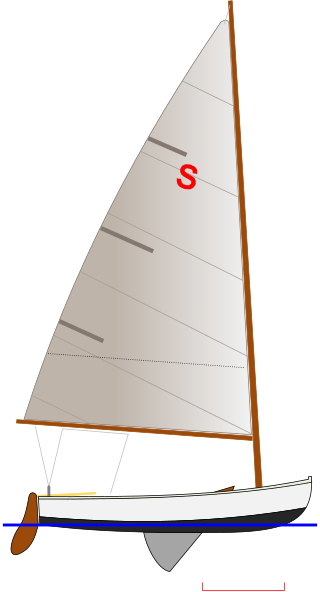
The Flying Scot is an American sailing dinghy that was designed by Sandy Douglass as a one-design racer and first built in 1958.
The Javelin, also called the Javelin 14 and O'Day Javelin is an American sailing dinghy that was designed by Uffa Fox as a one-design racer and first built in 1960.

The Flying Dutchman is a Dutch planing sailing dinghy that was designed by Uus Van Essen and Conrad Gülcher as a high performance, one design racer and first built in 1951.

The Snipe is an American sailing dinghy that was designed by William F. Crosby as a one design racer and first built in 1931.

The International FJ is a Dutch sailboat that was designed by Uus Van Essen and Conrad Gülcher as a trainer and one design racer, first built in 1956.

The C Scow is an American sailing dinghy that was designed by John O. Johnson as a one-design racer and first built as early as 1905. Sources disagree as to the first-built date, with claims of 1905, 1906 and 1923.

The Lido 14 is an American sailing dinghy that was designed by Barney Lehman and William D. Schock and first built in 1958.
The Rhodes 19 is an American trailerable day sailer or sailing dinghy, that was designed by Philip Rhodes as a one-design racer and first built in 1958.

The Penguin is an American sailing dinghy that was designed by Philip Rhodes in 1933 as a one design racer for frostbite racing on the US east coast and first built in 1939.
The Coronado 15 is an American sailing dinghy that was designed by Frank V. Butler as a one-design racer and first built in 1968.

The Snowbird is an American sailboat that was initially designed by Willis Reid as a one design racer and first built in 1921. The boat was re-designed by Edson B. Schock in the 1940s and it became a popular junior class.
The Interclub Dinghy is an American sailing dinghy that was designed by Sparkman & Stephens as a one-design racer and first built in 1946. It is sailed in frostbite racing on the US east coast, particularly on Long Island Sound. Frostbite races are the series held after the normal sailing season is finished.
The Howmar 12, sometimes written Howmar Twelve, is an American sailing dinghy that was designed by Craig V. Walters of Sparkman & Stephens as a one-design racer, trainer and day sailer and first built in 1983.
The Widgeon 12 is an American sailing dinghy that was designed by Robert H. Baker and first built in 1964. The design has been raced but is more often employed in the sail training role.
The Rascal 14 is an American sailing dinghy that was designed by Ray Greene and first built in 1961.
The US1, sometimes written US 1, is an American sailing dinghy that was designed by Ralph Kuppersmith and Clark Mills as a one-design racer and first built in 1973.
The Precision 16 is an American sailing dinghy that was designed by Stephen Seaton and first built in 1982.
The Catalina Catamaran is an American catamaran sailboat that was designed by W. D. Schock Corp's in-house designer, Seymour Paul, as a racer and day sailer, It was first built in 1960.
The Lehman 12 is an American sailboat that was designed by Barney Lehman as a one design racing sailing dinghy and first built in 1953.
The US Sabot is an American pram sailboat that was designed by Charles McGregor as a one-design racer and first built in 1939.









